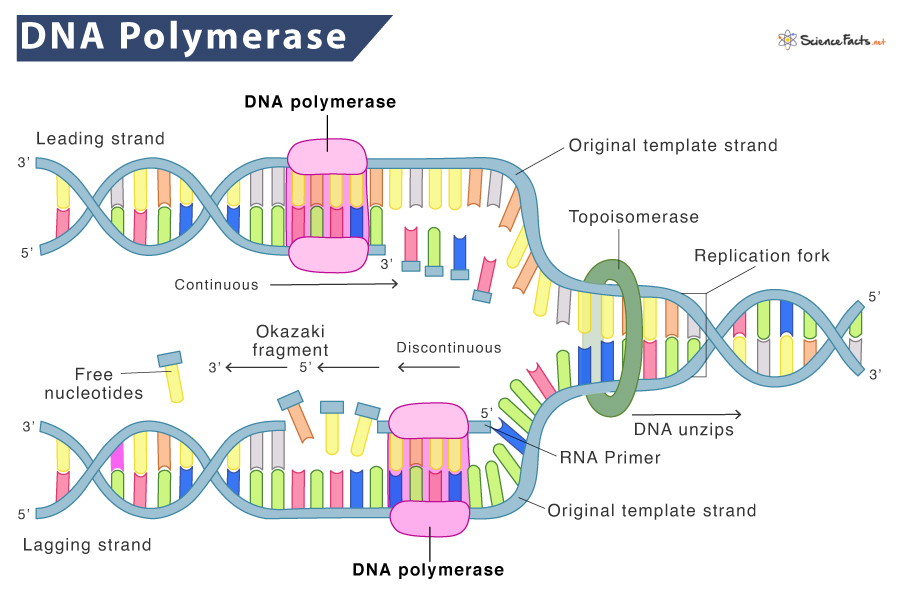Nowadays, scientists use DNA polymerase to copy the parent template strand for large-scale production of DNA through the polymerase chain reaction or PCR. Arthur Kornberg isolated and characterized DNA polymerase from the bacteria Escherichia coli (E. coli) in 1956. DNA polymerases were discovered not only in prokaryotes. In the 1970s and 1980s, scientists identified and characterized several DNA polymerases in eukaryotic organisms, including humans.
Mechanism of How DNA Polymerase Works
Types and Structure of DNA Polymerases
What are the Functions of DNA Polymerase
Deoxynucleoside triphosphate + DNAn ⇌ Pyrophosphate + DNAn+1 DNA polymerase needs a template strand and a short RNA oligonucleotide primer to initiate replication by adding nucleotides only at the 3’ end of the growing chain. Since DNA polymerase moves in the 5’→3’ direction, replication always occurs in the same direction. Replication is an exact and accurate process. The 3’→5’ exonuclease function of the enzyme removes incorrectly added nucleotides during replication, preventing DNA mutation. During proofreading, DNA polymerase checks each added nucleotide after incorporating it and removes it if there is a mismatch through its 3’→5’ exonuclease function.
Prokaryotic DNA Polymerase
Five DNA polymerases are identified in E.coli, each differing in structure, functions, polymerization rate, and processivity.
DNA Polymerase I (Pol I) is endoded by polA gene. DNA Pol I is a monomeric enzyme with a molecular weight of around 103 kDa and consisting of a single polypeptide chain. It has both 5’→3’ and 3’→5’ exonuclease activity. The 5’→3’ exonuclease activity removes the RNA primer from the lagging strand. Also, it fills the gaps by a process known as nick translation.DNA Polymerase II (Pol II) is encoded by the polB gene. Like DNA pol I, it is also a monomeric enzyme weighing almost 90 kDa. With 7 subunits, it is primarily involved in DNA repair processes, particularly when DNA is damaged by factors such as UV radiation or chemicals through its 3’→5’ exonuclease activity.DNA Polymerase III (Pol III) is encoded by the polC gene and is the primary replication enzyme in E. coli. It is a large, multi-subunit complex with ten different subunits. DNA Pol III consists of three core subunits (α, ε, and θ) and several accessory subunits. Two molecules of DNA polymerase III bind to the primers on the leading and lagging strands and synthesize new DNA from the 3′ hydroxyls. Through its 3’→5’ exonuclease activity, it performs high-fidelity DNA replication.DNA Polymerase IV (Pol IV) is encoded by the dinB gene. They mainly function in DNA repair during SOS response, when DNA replication is halted at the replication fork.DNA Polymerase V (Pol V) is also responsible for SOS response and DNA repair.
Eukaryotic DNA Polymerase
Like prokaryotic polymerases, eukaryotes use a more complex array of DNA polymerases than prokaryotes due to their larger genomes and increased need for DNA repair and replication fidelity. Here is the list of the five main polymerases found in eukaryotes.
DNA Polymerase α (Pol α) is a multi-subunit enzyme with four subunits: two large catalytic subunits and two small primase subunits. It is involved in initiating DNA synthesis during replication through its primase activity. A primase is a single-stranded DNA-dependent RNA polymerase that produces an oligonucleotide RNA template that serves as the starting point for DNA replication by DNA Polymerase δ. DNA Pol α also has a 3’→5’ exonuclease activity for proofreading.DNA Polymerase δ (Pol δ) is the main enzyme for replication in eukaryotes. It is a multi-subunit enzyme with three core subunits (p125, p50, and p66) and accessory factors. Apart from replication, Pol δ also has 3’→5’ exonuclease activity for proofreading.DNA Polymerase ε (Pol ε) is another multi-subunit enzyme with four subunits. It plays a role in DNA repair, removes primers from Okazaki fragments of the lagging strand, and participates in leading strand DNA synthesis during replication.DNA Polymerase γ (Pol γ) is the main replicative enzyme for mitochondrial DNA.DNA Polymerase ζ (Pol ζ) is a heterodimeric enzyme with two subunits (Rev3 and Rev7). It is also involved in specialized DNA repair processes, particularly for repairing DNA lesions that are challenging to replicate.
Role in DNA Replication
The primary function of the DNA polymerase is to synthesize new DNA strands through replication. It helps transfer genetic information from the parent to the offspring. They work in pairs, in tandem, for the two strands. DNA polymerase catalyzes the synthesis of complementary DNA strands to the template strands. This process ensures that the two resulting DNA molecules are identical to the original one.
DNA Proofreading and Repair
The proofreading activity of DNA polymerases is achieved through the following three functions:
3’ to 5’ Exonuclease Activity: Through this function, DNA polymerases can remove mismatched or incorrectly inserted nucleotides from the growing DNA strand, replacing them with the correct ones.5’ to 3’ Exonuclease Activity: Apart from the 3’ to 5’ exonuclease activity, specific DNA polymerases also have a 5’ to 3’ exonuclease activity. This activity is primarily associated with removing RNA primers during DNA replication.Mismatch Repair: In addition to the proofreading job of DNA polymerases, cells have dedicated mismatch repair systems. These systems identify and correct errors that escape the initial proofreading, further enhancing replication accuracy. Mismatch repair enzymes recognize distortions or mispairings in the DNA double helix and excise the incorrect section of DNA, allowing DNA polymerases to resynthesize the correct sequence.
